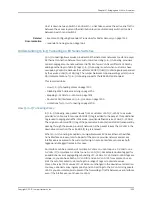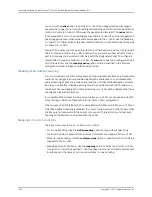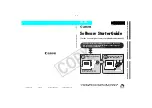
Link 1 is down between Switch 3 and Switch 1. Link 2 takes over as the active link. Traffic
between the access layer and the distribution layer is automatically switched to Link 2
between Switch 1 and Switch 2.
Related
Documentation
Example: Configuring Redundant Trunk Links for Faster Recovery on page 1343
•
•
redundant-trunk-group on page 1462
Understanding Q-in-Q Tunneling on EX Series Switches
Q-in-Q tunneling allows service providers on Ethernet access networks to extend a Layer
2 Ethernet connection between two customer sites. Using Q-in-Q tunneling, providers
can also segregate or bundle customer traffic into fewer VLANs or different VLANs by
adding another layer of 802.1Q tags. Q-in-Q tunneling is useful when customers have
overlapping VLAN IDs, because the customer’s 802.1Q (dot1Q) VLAN tags are prepended
by the service VLAN (S-VLAN) tag. The Juniper Networks Junos operating system (Junos
OS) implementation of Q-in-Q tunneling supports the IEEE 802.1ad standard.
This topic describes:
•
How Q-in-Q Tunneling Works on page 1293
•
Disabling MAC Address Learning on page 1294
•
Mapping C-VLANs to S-VLANs on page 1294
•
Routed VLAN Interfaces on Q-in-Q VLANs on page 1295
•
Limitations for Q-in-Q Tunneling on page 1296
How Q-in-Q Tunneling Works
In Q-in-Q tunneling, as a packet travels from a customer VLAN (C-VLAN) to a service
provider's VLAN, a customer-specific 802.1Q tag is added to the packet. This additional
tag is used to segregate traffic into service-provider-defined service VLANs (S-VLANs).
The original customer 802.1Q tag of the packet remains and is transmitted transparently,
passing through the service provider's network. As the packet leaves the S-VLAN in the
downstream direction, the extra 802.1Q tag is removed.
When Q-in-Q tunneling is enabled on Juniper Networks EX Series Ethernet Switches,
trunk interfaces are assumed to be part of the service provider network and access
interfaces are assumed to be customer facing. An access interface can receive both
tagged and untagged frames in this case.
An interface can be a member of multiple S-VLANs. You can map one C-VLAN to one
S-VLAN (1:1) or multiple C-VLANs to one S-VLAN (N:1). Packets are double-tagged for
an additional layer of segregating or bundling of C-VLANs. C-VLAN and S-VLAN tags are
unique; so you can have both a C-VLAN 101 and an S-VLAN 101, for example. You can
limit the set of accepted customer tags to a range of tags or to discrete values.
Class-of-service (CoS) values of C-VLANs are unchanged in the downstream direction.
You may, optionally, copy ingress priority and CoS settings to the S-VLAN. Using private
VLANs, you can isolate users to prevent the forwarding of traffic between user interfaces
even if the interfaces are on the same VLAN.
1293
Copyright © 2010, Juniper Networks, Inc.
Chapter 57: Bridging and VLANs—Overview
Summary of Contents for JUNOS OS 10.3 - SOFTWARE
Page 325: ...CHAPTER 17 Operational Mode Commands for System Setup 229 Copyright 2010 Juniper Networks Inc ...
Page 1323: ...CHAPTER 56 Operational Mode Commands for Interfaces 1227 Copyright 2010 Juniper Networks Inc ...
Page 2841: ...CHAPTER 86 Operational Commands for 802 1X 2745 Copyright 2010 Juniper Networks Inc ...
Page 3367: ...CHAPTER 113 Operational Mode Commands for CoS 3271 Copyright 2010 Juniper Networks Inc ...
Page 3435: ...CHAPTER 120 Operational Mode Commands for PoE 3339 Copyright 2010 Juniper Networks Inc ...
Page 3529: ...CHAPTER 126 Operational Mode Commands for MPLS 3433 Copyright 2010 Juniper Networks Inc ...
















































